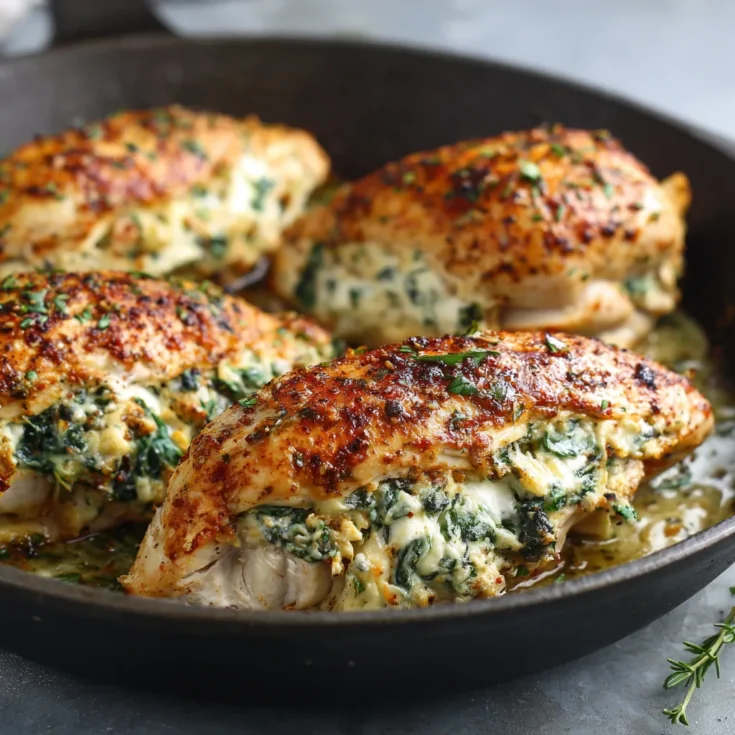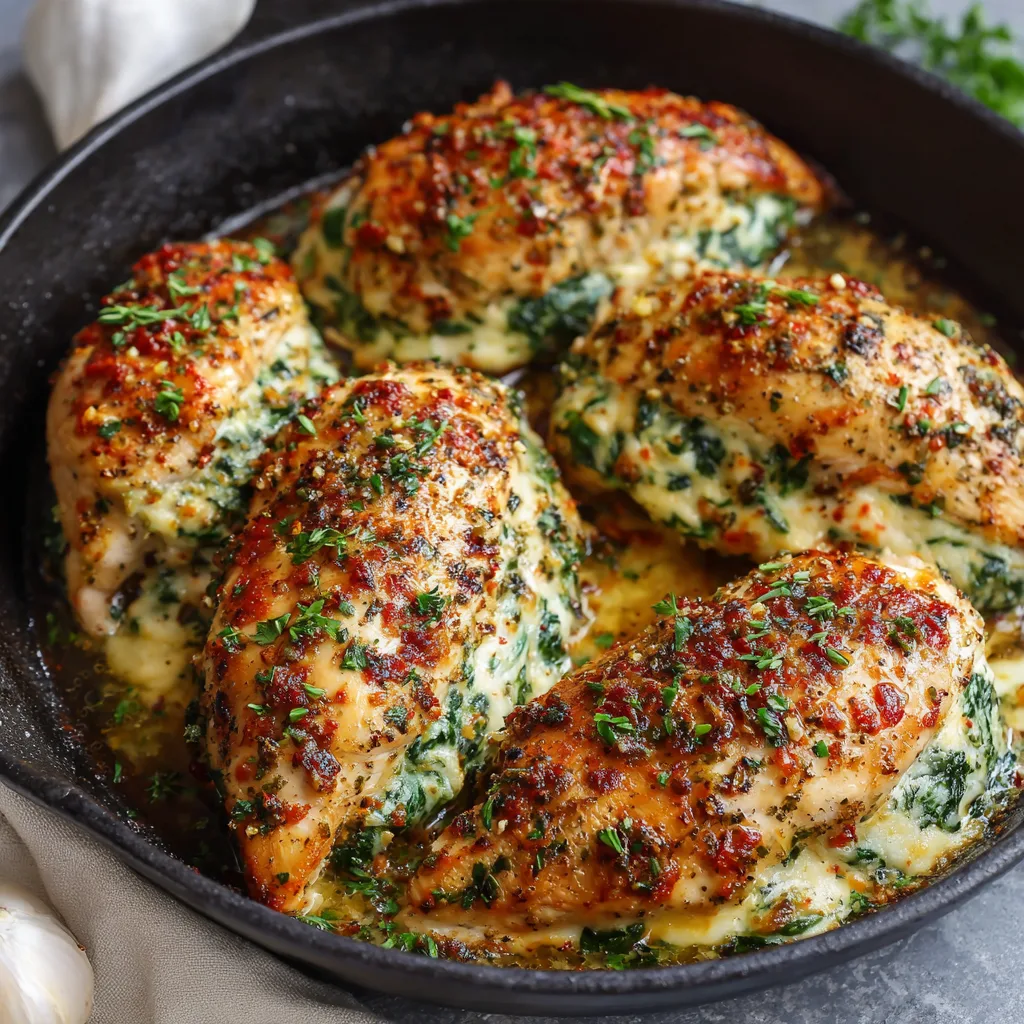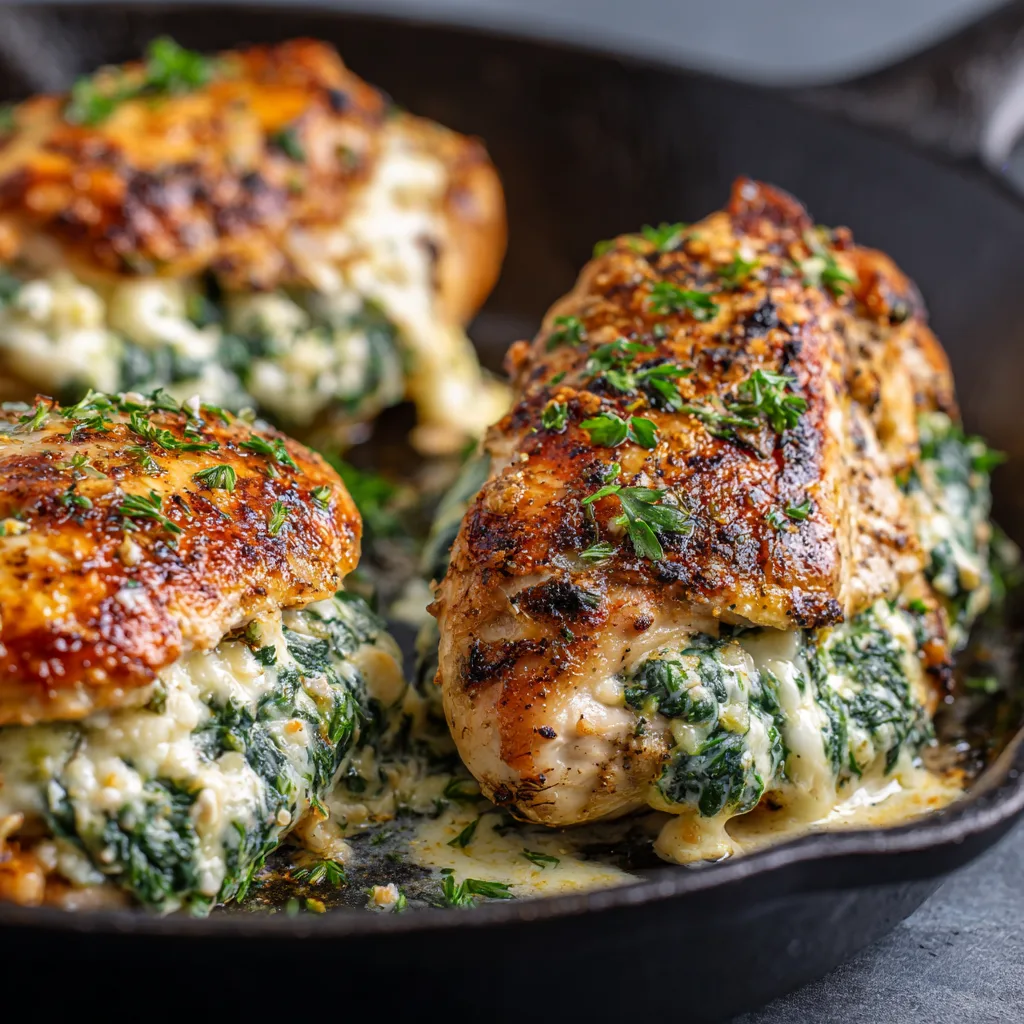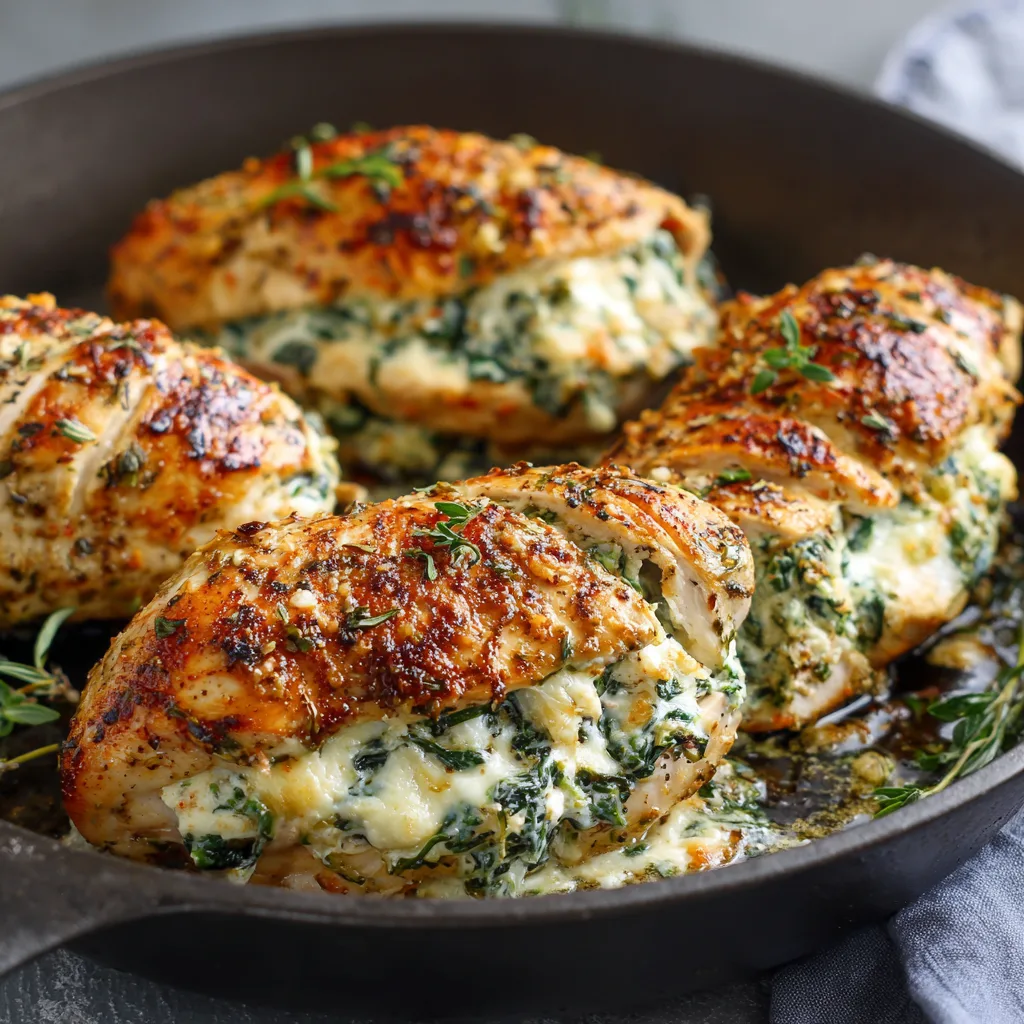What Is a Quick Stuffed Chicken Breast Skillet?
A quick stuffed chicken breast skillet combines tender chicken breasts filled with flavorful ingredients, all cooked in a single pan. This method delivers a delicious, satisfying meal without the fuss of multiple pots and pans. It’s perfect for busy weeknights when time is limited but you still want a wholesome dinner. The skillet approach ensures the chicken cooks evenly while sealing in moisture and stuffing flavors. This one-pan dish saves both time and cleanup, making it a favorite for home cooks seeking convenience without sacrificing taste.
Why Choose the Skillet Method?
Cooking stuffed chicken breasts in a skillet offers several advantages compared to traditional oven baking. First, it significantly cuts down cooking time by using direct heat and quick searing techniques. This faster method means you get dinner on the table sooner, which is ideal for hectic schedules. Additionally, skillet cooking uses less energy than heating up an entire oven. More importantly, the skillet’s intense heat helps lock in the chicken’s juices, keeping the meat tender and moist. This searing step also creates a flavorful golden crust that enhances the dish’s texture and appeal.
Popular Stuffing Combinations for Skillet Chicken Breasts
Stuffing choices can transform a simple chicken breast into a gourmet meal. Classic spinach and cream cheese offer a creamy, mild filling that pairs well with the chicken’s natural flavor. Sun-dried tomatoes combined with mozzarella add a rich, tangy taste and melt-in-your-mouth texture. A blend of feta, spinach, and garlic introduces a Mediterranean flair with bright, savory notes. For those who enjoy bold flavors, bacon and cheddar create a smoky, cheesy stuffing that elevates the dish. These combinations keep the skillet chicken exciting and versatile, allowing easy customization to suit any palate.
Essential Ingredients for Stuffed Chicken Breasts
Choosing the right ingredients sets the foundation for a flavorful stuffed chicken breast. Start with boneless, skinless chicken breasts that are thick enough—about ¾ to 1 inch—to hold the stuffing without tearing. Using chicken of uniform size ensures even cooking. For stuffing, opt for creamy bases like cream cheese combined with fresh spinach, aromatic herbs, or sun-dried tomatoes. Incorporate cheeses such as mozzarella, feta, or cheddar for richness. Seasonings bring depth; common choices include salt, black pepper, garlic powder, smoked paprika, and Italian seasoning blends. To keep the stuffing intact during cooking, use binding agents like toothpicks, kitchen twine, or small skewers. These tools secure the chicken and prevent filling from spilling out.
Preparation Steps for Perfect Stuffed Chicken Breasts
Butterflying the chicken properly creates a pocket for stuffing and ensures even thickness for cooking. Use a sharp knife to slice horizontally through the chicken breast, stopping just short of cutting all the way through. This technique opens the breast like a book, providing space for fillings. Season the inside and outside generously to enhance flavor throughout. When stuffing, spread the mixture evenly but avoid overfilling, as this can cause leaks during cooking. Roll or fold the breast carefully, then seal it tightly with toothpicks or twine. This helps maintain shape and traps juices inside while cooking.
Cooking Equipment: Skillet and Thermometer Essentials
A heavy-bottomed skillet, such as cast iron, works best for cooking stuffed chicken breasts. Cast iron holds and distributes heat evenly, allowing a perfect sear and consistent cooking. Non-stick skillets can also be used but may not achieve the same crust. Using a meat thermometer is critical to ensure food safety and quality. Insert it into the thickest part of the chicken to confirm the internal temperature reaches 165°F (74°C). This step prevents undercooking or overcooking, preserving moisture and tenderness. With the right tools and careful preparation, your stuffed chicken will cook perfectly every time.
Stovetop Skillet Cooking for Stuffed Chicken Breasts
Searing stuffed chicken breasts properly sets the stage for a flavorful and visually appealing dish. Begin by heating your skillet over medium-high heat and adding a small amount of oil. Once hot, place the chicken breasts seam side down to seal the stuffing inside. Sear each side for about 3-4 minutes until you achieve a deep golden crust. This crust locks in juices and enhances flavor. To finish cooking without drying out the chicken, reduce the heat to medium-low, cover the skillet, and cook gently for an additional 10 to 12 minutes. This allows the heat to penetrate evenly, cooking the chicken through while preserving moisture. Time management is key: balancing searing and simmering ensures the stuffing stays warm and the chicken remains tender.
Oven Finishing: When and How to Use the Oven for Stuffed Chicken
Sometimes, after searing on the stovetop, transferring the skillet to the oven ensures thorough cooking. Transfer the chicken when it develops a good crust but remains undercooked inside. This step is especially useful for thicker breasts or if the stuffing requires additional heat to melt completely. Preheat your oven to 350°F (175°C) for even cooking. Place the skillet or a baking dish in the oven and cook for 12 to 15 minutes, checking regularly with a meat thermometer. Avoid overcooking by removing the chicken as soon as it reaches 165°F (74°C) internally. This method preserves juiciness and texture while finishing the dish safely.
Alternative Cooking Methods for Stuffed Chicken Breasts
Grilling stuffed chicken breasts adds a smoky flavor and appealing grill marks. Use indirect heat by placing the chicken away from direct flames to avoid burning the stuffing. Turn often and monitor closely. For air frying, preheat the air fryer to 360°F (182°C). Cook stuffed breasts for 15 to 18 minutes, flipping halfway through, ensuring the internal temperature reaches 165°F. Slow cooking is less common but possible. Use a slow cooker on low for 3 to 4 hours, placing chicken breasts in a tight seam-up position and adding minimal liquid to avoid sogginess. Each method offers unique benefits and flavor profiles, giving you flexibility to suit your kitchen and preferences.
Flavor Variations and Customizations for Stuffed Chicken
Experiment with fresh herb blends like thyme, rosemary, or oregano to brighten the filling with aromatic notes. Swap out cheeses to vary richness and texture—try ricotta for creaminess, tangy goat cheese for boldness, or gouda for a smoky twist. Adding vegetables like sautéed mushrooms, diced bell peppers, or shredded zucchini adds color, nutrients, and depth. Adjust spices to personalize flavor profiles; paprika, cumin, or chili flakes can introduce warmth or heat, while lemon zest adds brightness. These variations keep the recipe exciting and allow it to fit any taste preference or occasion.
Complementary Side Dishes for Stuffed Chicken Breast Skillet
Pairing your stuffed chicken breast with the right sides elevates the meal. Vegetables like roasted asparagus bring a crisp, earthy flavor that complements the richness of the chicken. Sautéed green beans offer a light, fresh crunch, while steamed broccoli adds vibrant color and a mild, nutritious balance. For carbohydrates, creamy mashed potatoes provide comfort and texture. Rice pilaf introduces subtle herbs and fluffiness, and quinoa offers a protein-packed, nutty alternative. Fresh salads also pair well: a crisp garden salad adds refreshing contrast, Caesar salad delivers savory, tangy notes, and a Greek salad brings bright, Mediterranean flavors to the plate.
Sauces and Condiments to Enhance Flavor
Using pan drippings to create a sauce intensifies the meal’s flavor while reducing waste. After cooking, deglaze the skillet with a splash of broth or lemon juice, scraping up browned bits to form a rich pan sauce. For added creaminess, serve alongside dips like garlic aioli or cool tzatziki, which provide contrasting textures and tastes. Glazes such as balsamic reduction or honey mustard add a sweet and tangy dimension. These sauces and condiments complement the stuffed chicken’s flavors and make every bite more indulgent.
Presentation Tips for Serving Stuffed Chicken
Visual appeal plays a crucial role in meal enjoyment. Arrange stuffed chicken breasts neatly on the plate, placing them slightly overlapping or sliced to showcase the filling. Garnish with fresh herbs like parsley or basil to add a pop of green and fresh aroma. Thin citrus slices, such as lemon or orange, brighten the presentation and hint at subtle acidity in the dish. Decide whether to serve family-style on a platter for communal sharing or individually plated for a formal setting. Thoughtful plating enhances the dining experience and makes your quick stuffed chicken breast skillet feel special.
Common Challenges and Solutions When Cooking Stuffed Chicken Breasts
Dry chicken often results from overcooking or cooking at too high a temperature. To avoid dryness, monitor the internal temperature closely and remove the chicken from heat as soon as it reaches 165°F (74°C). Using a meat thermometer prevents guesswork and keeps the meat juicy. Leaking stuffing can ruin the presentation and texture. Prevent leaks by butterflying the chicken carefully without cutting through completely and avoiding overstuffing. Secure the edges firmly with toothpicks or kitchen twine to hold everything in place during cooking. Uneven cooking happens when the skillet’s heat is too high or chicken breasts vary in size. Use a heavy-bottomed skillet for consistent heat distribution and select chicken breasts of similar thickness for even cooking.
Expert Tips for Perfect Stuffed Chicken Breasts Every Time
Let the chicken rest for at least five minutes after cooking. Resting allows the juices to redistribute, making the meat tender and flavorful. Always aim for an internal temperature of 165°F (74°C) to ensure the chicken is safe to eat while maintaining moisture. When storing leftovers, place them in an airtight container and refrigerate within two hours of cooking to preserve freshness. For reheating, use gentle methods like oven warming at low temperature or stovetop heating covered with foil or a lid. This helps retain moisture and prevents the chicken from drying out, keeping your stuffed chicken delicious even the next day.
Frequently Asked Questions
Q1: How do I prevent the stuffing from leaking out during cooking?
Make sure to seal the chicken well with toothpicks or twine. Avoid overfilling the breasts to keep the stuffing inside.
Q2: Can I prepare the stuffed chicken breasts in advance?
Yes, you can assemble and refrigerate them for up to 24 hours before cooking.
Q3: What can I substitute for cream cheese in the stuffing?
Try ricotta, goat cheese, or a mix of Greek yogurt and shredded cheese for alternative creamy fillings.
Q4: How can I make this recipe gluten-free?
Use gluten-free seasonings and verify all cheeses are gluten-free to keep the dish safe for gluten-sensitive diets.
Q5: Can I freeze the stuffed chicken breasts?
Yes, freeze them uncooked for up to 3 months. Thaw thoroughly in the refrigerator before cooking.
Quick Stuffed Chicken Breast Skillet – Easy One-Pan Dinner Recipe

This savory dish features tender chicken breasts filled with a creamy spinach and cheese mixture, cooked perfectly in a skillet. It’s an easy, flavorful meal ideal for busy weeknights.
Ingredients
- 4 boneless, skinless chicken breasts
- 8 oz cream cheese, softened
- 1 cup fresh spinach, chopped
- ½ cup shredded mozzarella cheese
- ¼ cup grated parmesan cheese
- 2 cloves garlic, minced
- 1 tablespoon olive oil
- Salt and pepper, to taste
- 1 teaspoon smoked paprika
- Toothpicks or kitchen twine for securing
Instructions
Notes




